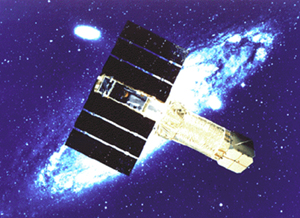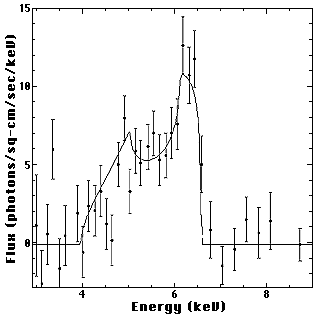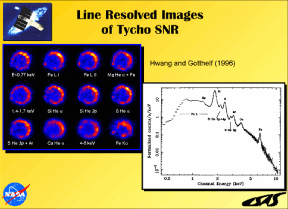Imagine the Universe News - 20 March 2001
The Grand ASCA Mission: 1993-2001
| 20 March 2001 |

ASCA Satellite
|
What goes up, must come down. ASCA, a workhorse of an X-ray observatory that provided astronomers their first real glimpse of black holes, is no exception.
After nearly eight years of steady observations from space, ASCA surrendered to gravity and reentered the earth's atmosphere, as expected, on March 2, 2001, bringing the highly successful ASCA mission to a close.
Far from lamenting its passing, astronomers will be busy for several years to come analyzing the vast archives of ASCA data. And the ASCA legacy will continue to shape the Chandra X-ray Observatory and XMM-Newton missions, two next-generation satellites now in orbit that study many of the sources ASCA first gazed upon.
ASCA stands for the Advanced Satellite for Cosmology and Astrophysics, a Japan-led mission with NASA support launched in 1993. ASCA was largely a spectroscopy mission. Its instruments did not produce high-quality images like Chandra and Hubble. Rather, ASCA produced spectra, sort of like chemical fingerprints that reveal the properties of hot gas swirling around a black hole or rushing away at near light speed from a star explosion.

ASCA's Observation of the Iron K Spectral Line broadened by relativistic effects near a black hole.
|
Matter Falling into Black Holes
Arguably one of ASCA's greatest achievements was the discovery in active galaxies of the broad iron K line, a specific type of spectral line and the telltale sign that the crushing force of a black hole's gravity is beating up on matter. The iron K line grows "broad" from intense gravity. Albert Einstein had predicted the shape of the broad line around a black hole in his theory of general relativity, and that's just what ASCA saw.Seeing a broad iron K line meant that ASCA was probing deeper into the region around a black hole than ever before, even deeper than what Hubble probes. Gas will only emit broadened spectra like this when it is very close to the event horizon, the theoretical point-of-no-return around a black hole. Prof. Andrew Fabian (Institute of Astronomy, England) and Prof. Yasuo Tanaka (Institute for Space and Astronautical Science, Japan) won the prestigious Rossi award this year from the American Astronomical Society for their iron K line work.
Fabian also calculated that black holes may be responsible for up to 50 percent of universe's total energy output. Fabian and his colleague, Dr. Kazushi Iwasawa, determined that some of the dimmer supermassive black holes are actually less massive black holes working overtime, not very massive black holes acting lazy. Dr. Paul Nandra at NASA Goddard Space Flight Center saw the first evidence of matter actually falling into a black hole, not just swirling around. Dr. Ed Colbert of Johns Hopkins University found the first mid-mass black holes, objects in between the mass of stellar and supermassive black holes. All this from ASCA data.
ASCA was instrumental is mapping the flow of gas onto compact objects, namely black holes, neutron stars and white dwarfs. Cataclysmic variables and X-ray binaries are systems in which one star is a "living" hydrogen- or helium-burning star and the other star is a compact object, a strong source of gravity. Gas from the healthy star transfers onto the compact object. ASCA tracked this voyage and provided evidence that the gas exhibits a wide range of temperatures -- from 1 million degrees to 10 million degrees to 100 million degrees -- depending on where the gas is around the compact object.

Line Resolved Images of Tycho SNR
|
Neutron Stars and Supernova Remnants
Neutron stars and black holes form from supernovae. Yet, before ASCA, very few neutron stars were known inside supernova remnants. ASCA identified several neutron stars, such as RCW 103 and Kes 73. Astronomers also capitalized on ASCA's "fingerprinting" capability to detail the distribution of elements in the supernova remnants Tycho and W49B. All elements heavier than hydrogen and helium are created by stars and star explosions; ASCA was the first instrument to provide high-quality mapping of this process.Another big hit for ASCA was the discovery of cosmic rays shooting away from supernova 1006. Cosmic rays are atomic particles that whip through space at nearly light speed. Many astronomers suspected that these particles are accelerated to such speeds by star explosions, such as SN 1006, which Chinese astronomers actually recorded in the year 1006. ASCA provided the first observational evidence of cosmic ray acceleration.
Stars go out with a bang, with explosions that glow in X rays. ASCA discovered that protostars -- mere baby stars a day or week old, in human terms -- also emit X rays. ASCA was even sensitive enough to study stellar coronae, the thin, hot atmosphere surrounding most stars, including our own. Astronomers studied the abundances of elements such as iron, silicon and sulfur in unprecedented detail. Before ASCA, only the Sun's corona could be studies so thoroughly.
The Outer Reaches of the Universe
On the largest and most distant scale, ASCA studied clusters of galaxies. By mapping the flow of hot gas between galaxies -- enriched with carbon, oxygen and other elements from supernova explosions -- astronomers could determine that the early universe had more massive stars compared to the present era. We know this from measuring the abundance of elements in distant clusters, which could only have been produced from massive stars.Prof. Patrick Henry (University of Hawaii) has used the X rays from distant clusters of galaxies to measure the total mass density of the universe, including the elusive dark matter. His result was precise enough to show conclusively that there is not enough matter in the universe to stop its expansion.
ASCA was originally named Astro-D, signifying that it was the fourth in a series of Japanese satellites devoted to studying celestial X-ray sources, following Hakucho, Tenma and Ginga. A follow-up to ASCA is in the planning stage.

